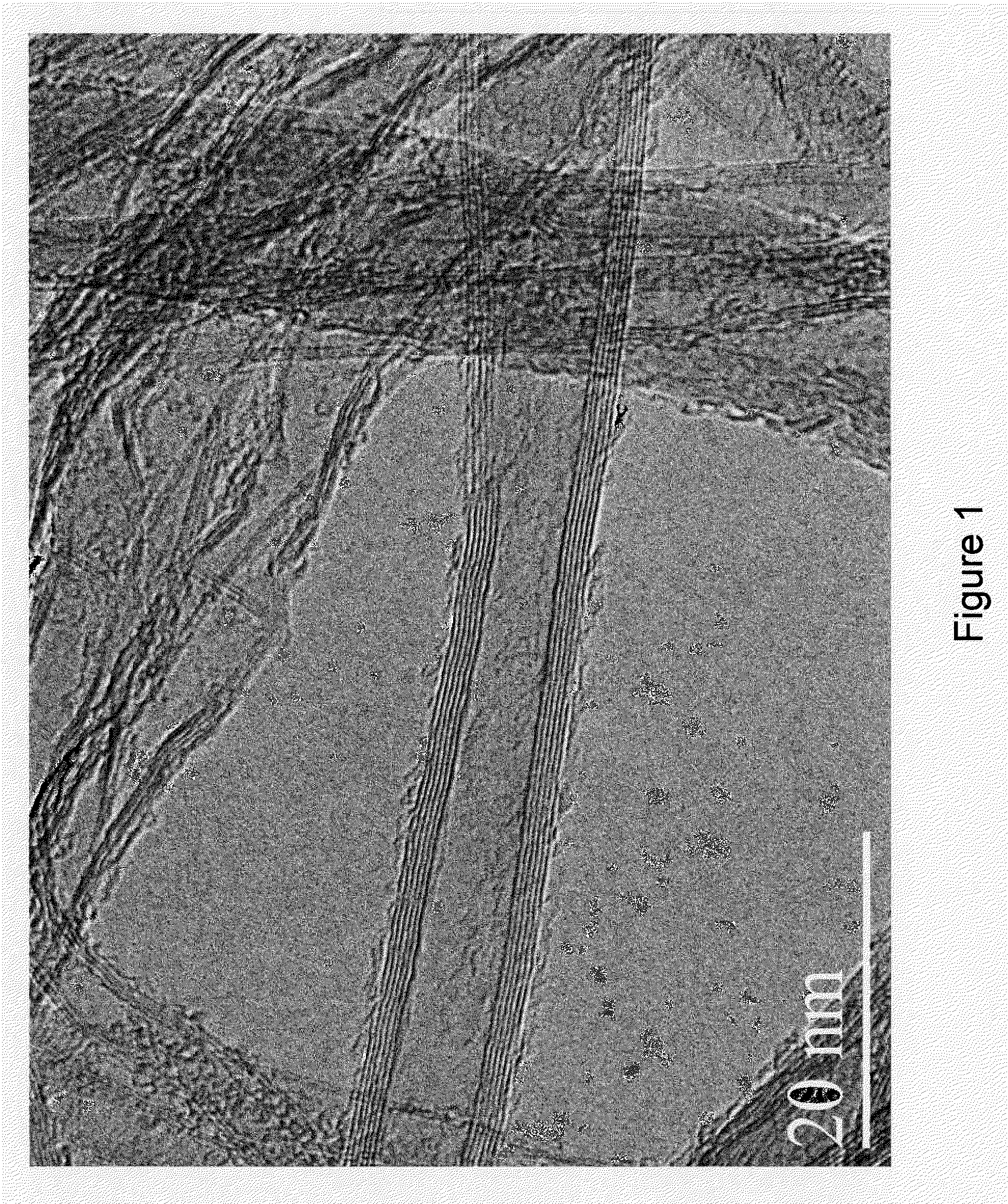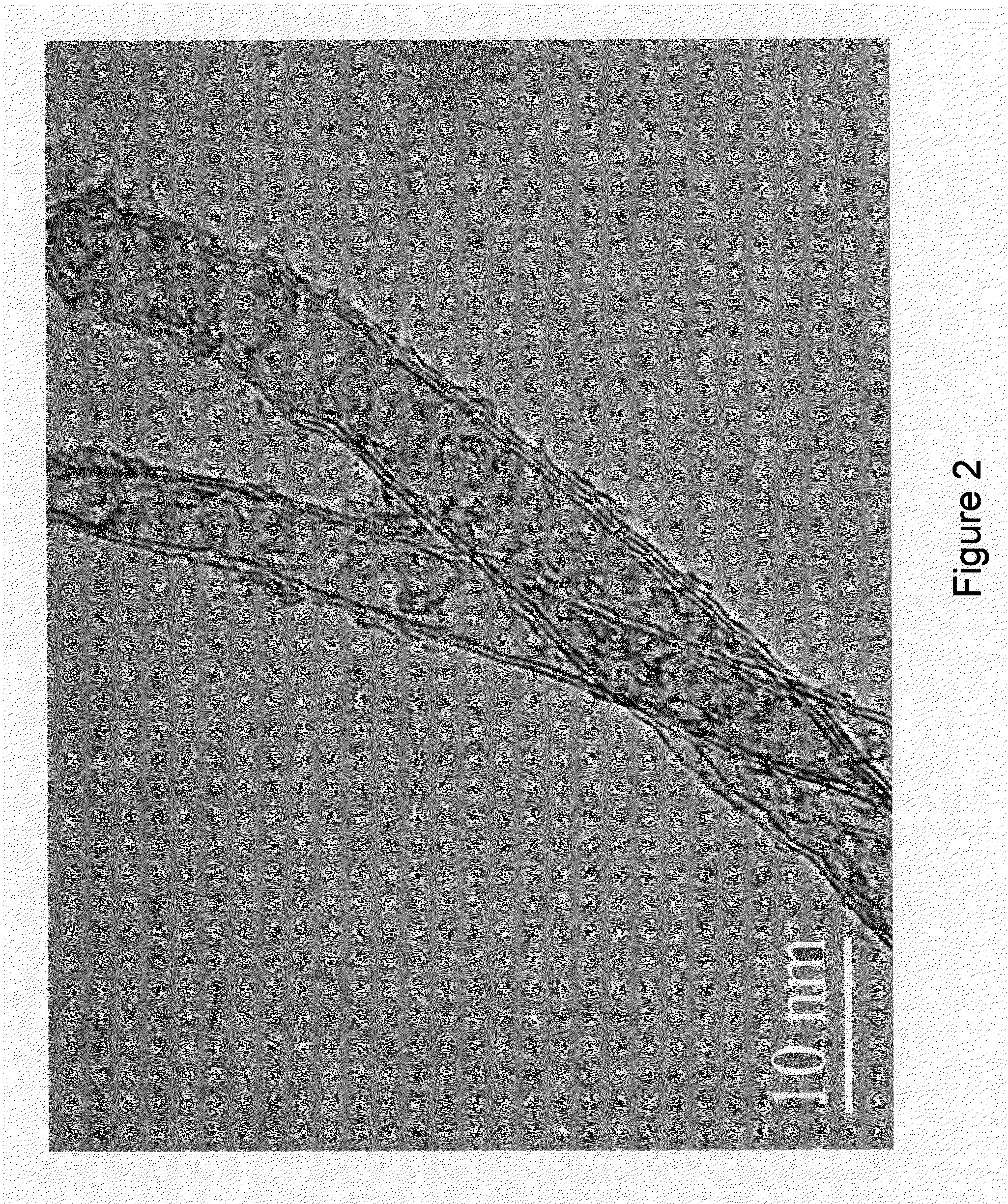Composites comprising carbon nanotubes on fiber
a technology of carbon nanotubes and composites, applied in the field of carbon nanotubes, can solve the problems of increasing the viscosity of the matrix, reducing the ability to impregnate the resulting composite, and limited compositions
- Summary
- Abstract
- Description
- Claims
- Application Information
AI Technical Summary
Problems solved by technology
Method used
Image
Examples
example i
[0180]This example shows how a carbon fiber material can be infused with CNTs in a continuous process to target thermal and electrical conductivity improvements.
[0181]In this example, the maximum loading of CNTs on fibers is targeted. 34-700 12k carbon fiber tow with a tex value of 800 (Grafil Inc., Sacramento, Calif.) is implemented as the carbon fiber substrate. The individual filaments in this carbon fiber tow have a diameter of approximately 7 μm.
[0182]FIG. 8 depicts system 800 for producing CNT-infused fiber in accordance with the illustrative embodiment of the present invention. System 800 includes a carbon fiber material payout and tensioner station 805, sizing removal and fiber spreader station 810, plasma treatment station 815, barrier coating application station 820, air dry station 825, catalyst application station 830, solvent flash-off station 835, CNT-infusion station 840, fiber bundler station 845, and carbon fiber material uptake bobbin 850, interrelated as shown.
[01...
example ii
[0197]This example shows how carbon fiber material can be infused with CNTs in a continuous process to target improvements in mechanical properties, especially interfacial characteristics such as shear strength. In this case, loading of shorter CNTs on fibers is targeted. In this example, 34-700 12k unsized carbon fiber tow with a tex value of 793 (Grafil Inc., Sacramento, Calif.) is implemented as the carbon fiber substrate. The individual filaments in this carbon fiber tow have a diameter of approximately 7 μm.
[0198]FIG. 9 depicts system 900 for producing CNT-infused fiber in accordance with the illustrative embodiment of the present invention, and involves many of the same stations and processes described in system 800. System 900 includes a carbon fiber material payout and tensioner station 902, fiber spreader station 908, plasma treatment station 910, catalyst application station 912, solvent flash-off station 914, a second catalyst application station 916, a second solvent fla...
example iii
[0215]This example shows how carbon fiber material can be infused with CNTs in a continuous process to target improvements in mechanical properties, especially interfacial characteristics such as interlaminar shear.
[0216]In this example, loading of shorter CNTs on fibers is targeted. In this example, 34-700 12k unsized carbon fiber tow with a tex value of 793 (Grafil Inc., Sacramento, Calif.) is implemented as the carbon fiber substrate. The individual filaments in this carbon fiber tow have a diameter of approximately 7 μm.
[0217]FIG. 10 depicts system 1000 for producing CNT-infused fiber in accordance with the illustrative embodiment of the present invention, and involves many of the same stations and processes described in system 800. System 1000 includes a carbon fiber material payout and tensioner station 1002, fiber spreader station 1008, plasma treatment station 1010, coating application station 1012, air dry station 1014, a second coating application station 1016, a second ai...
PUM
| Property | Measurement | Unit |
|---|---|---|
| Fraction | aaaaa | aaaaa |
| Fraction | aaaaa | aaaaa |
| Fraction | aaaaa | aaaaa |
Abstract
Description
Claims
Application Information
 Login to View More
Login to View More - R&D
- Intellectual Property
- Life Sciences
- Materials
- Tech Scout
- Unparalleled Data Quality
- Higher Quality Content
- 60% Fewer Hallucinations
Browse by: Latest US Patents, China's latest patents, Technical Efficacy Thesaurus, Application Domain, Technology Topic, Popular Technical Reports.
© 2025 PatSnap. All rights reserved.Legal|Privacy policy|Modern Slavery Act Transparency Statement|Sitemap|About US| Contact US: help@patsnap.com



